FidelityFX Super Resolution tests with Ryzen 5 5600G and AMD RX 6600 XT
Image rendering at scale has become one of the keys to gain performance and frames per second in demanding games with less powerful hardware. And this time we extend our AMD FSR article testing FidelityFX Super Resolution on Cezanne APU and Radeon 6600 XT GPU.
Index of contents

These are the two most recent releases of Team Red, on the one hand, for the multimedia equipment market with a CPU with integrated Radeon RX Vega graphics, and on the other the mid-range graphics card that competes with Nvidia’s RTX 3060. In addition, we will take advantage of the fact that a time has passed since its launch for a more established operation in the games.
Because one of the best things about FSR will be its compatibility with all types of graphics chips as long as it is implemented in the game, including APUs and GPUs from the competition and previous generations. Little by little AMD is introducing this function in more games, although Nvidia does the same with its DLSS, having a great struggle to see who does it better.
Brief review of FidelityFX Super Resolution and differences with DLSS

For those who are not yet familiar with this technology from AMD, its role is to improve the performance of frames per second or FPS in a game. This is achieved by scaling the output image to the monitor’s native resolution (or another selected one) from a lower resolution rendering.
Rendering images at a lower resolution greatly increases the ability to process frames within the GPU, and this will be crucial for generating smoother images. It will have several modes of operation that will determine the quality of the final image, a total of 4 where the rendering resolution changes from closer to further with respect to the native image. Obviously, the lower the resolution, the worse the image quality , but the more performance we will get.

FSR detects and recreates high resolution edges from the source rendering, which is a crucial detail to lose the lowest possible quality. It does this in two phases:
- Scaling phase called EASU (Edge-Adaptive Spatial Upsampling): The input frame is analyzed detecting gradient inversions. In this way, it observes the differences with the neighboring gradients in a set of pixels to know how to define the weights that will be applied to the reconstructed pixels at the native resolution.
- Sharpening phase called RCAS (Robust Contrast-Adaptive Shapering): consists of extracting the maximum detail of the pixels that generate the improved image to give the best possible quality.
| FSR configuration | Scale factor | Input resolution | Output resolution |
| Ultra Quality | 1.3x
77% native resolution |
1477 x 831
1970 x 1108 2646 x 1108 2954 x 1662 |
1920 x 1080
2560 x 1440 3440 x 1440 3840 x 2160 |
| Quality | 1.5x
67% native resolution |
1280 x 720
1706 x 960 2293 x 960 2560 x 1440 |
1920 x 1080
2560 x 1440 3440 x 1440 3840 x 2160 |
| Balanced | 1.7x
59% native resolution |
1129 x 635
1506 x 847 2024 x 847 2259 x 1270 |
1920 x 1080
2560 x 1440 3440 x 1440 3840 x 2160 |
| Performance | 2.0x
50% native resolution |
960 x 540
1280 x 720 1720 x 720 1920 x 1080 |
1920 x 1080
2560 x 1440 3440 x 1440 3840 x 2160 |
Resolution scales in the different FSR modes


FSR only uses software-based mechanisms and anti-aliasing filters to perform this over-scaling, a basic and crucial difference from DLSS . Nvidia’s solution requires training models and Artificial Intelligence to generate the DLSS model for each game, although this complexity pays off with higher image quality.
However, the greater simplicity of FSR makes it more easily applicable, and also compatible with all graphics chips unlike DLSS which is exclusive to Nvidia. In fact, AMD released the code so that it can be implemented in more graphics engines, just like FreeSync and other mechanisms.
Performance benchmarks and tests
Once we know what this technology is, we will go directly to the performance tests. For this we will use the latest generation of APUs that AMD brings, more specifically a Ryzen 5 5600G , as well as the Radeon RX 6600 XT mid-range GPU designed to play in Full HD.
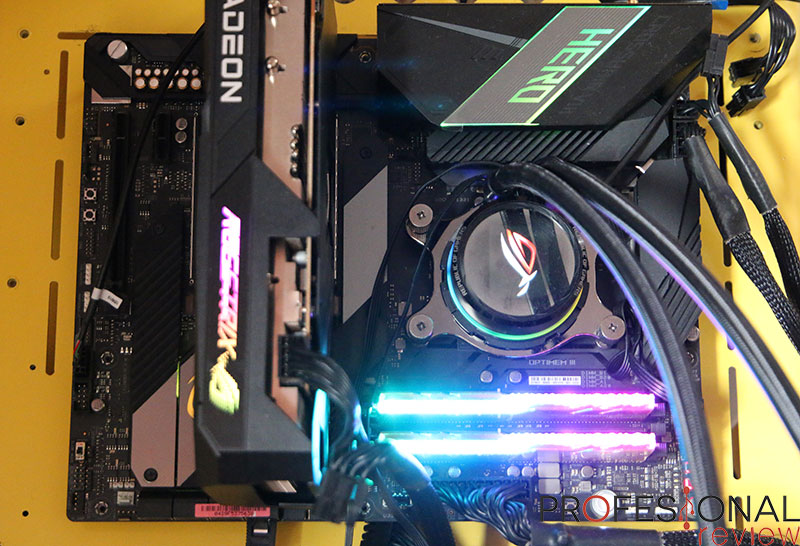
The test bed for the APU will consist of:
- Graphics card : AMD Radeon Graphics Vega 7
- CPU : AMD Ryzen 5 5600G
- Heatsink : Wraith Prism
- Motherboard : MSI B550M Mortar
- RAM : 16 GB G.Skill Trident Z Royal 3600 MHz
- Hard drive : 2 TB Samsung 860 QVO
- PSU : Cooler Master V850 Gold
- Monitor : ViewSonic VX3211 4K mhd
And the bank used for the dedicated GPU will consist of:
- Graphics card : AMD Radeon RX 6600 XT (Asus version)
- CPU : AMD Ryzen 9 5900X
- Heatsink : Asus ROG Ryuo 240
- Motherboard : Asus Crosshair VIII Hero
- RAM : 16 GB G.Skill Trident Z Royal 3600 MHz
- Hard drive : 2 TB Samsung 860 QVO
- PSU : Cooler Master V850 Gold
- Monitor : ViewSonic VX3211 4K mhd
In this case we will only evaluate FSR in Balanced mode to give a more useful benchmark performance result in games.
FidelityFX Super Resolution on APU Cezanne: Real Gaming Option

We have for this the AMD Ryzen 5 5600G , a processor that debuts the Cezanne architecture in turn based on the 7 nm TSMC die improved from the Zen 3 processors. It has 6 cores and 12 unlocked threads , at a maximum frequency of 4, 4 GHz and with 16 MB of L3 cache. All this with a 65W TDP that can be cooled without much problem by its stock Wraith Stealth heatsink.
But the most interesting for us in this case will be its integrated AMD Radeon RX Vega 7 GPU , being on the same chiplet as the CPU and composed of 7 cores . Its fixed working frequency will be 1900 MHz , with a total of 448 shading units (64 per core), and generating 8 ROPs and 28 TMUs .
The tests have been carried out in resolution 1920x1080p and 2560x1440p with the following games:
- Godfall : Bass, DX12
- Terminator Resistance : Low, DX12
- The Riftbreaker : Bass: DX12
- Anno 1800 : Bass, DX12
- Resident Evil: Village : Low, DX12
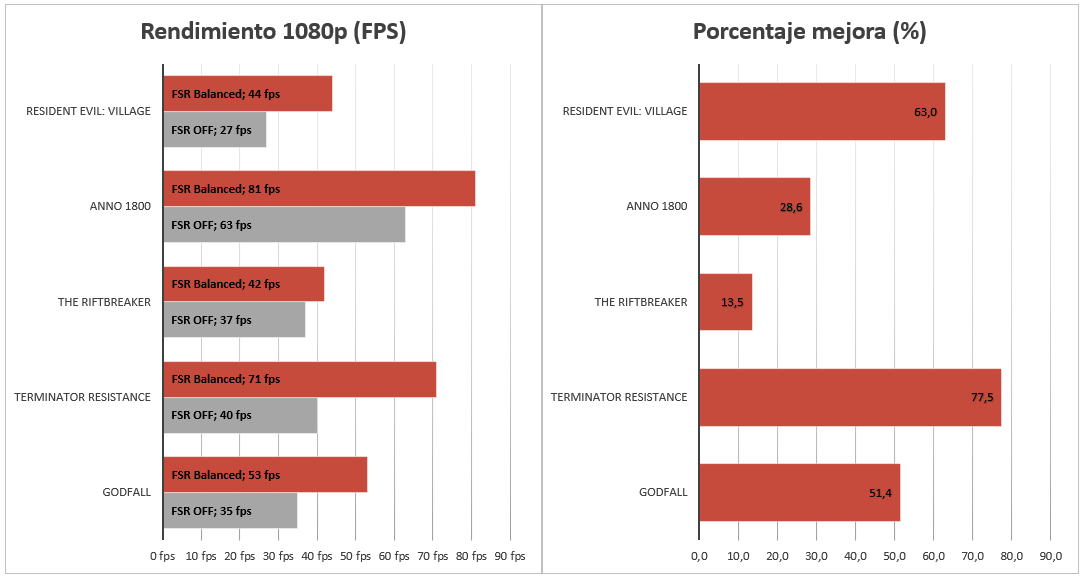
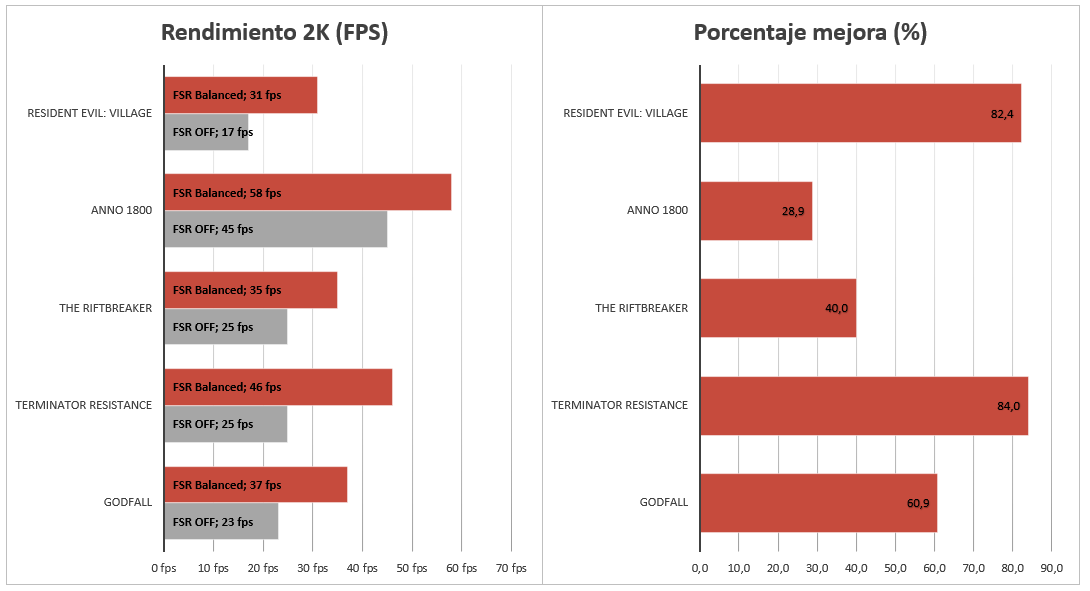
We see the great evolution of these integrated graphics already from the tests without FSR, because in Full HD with low quality we are reaching more than 30 FPS relatively easily . We must bear in mind that they are quite demanding games, for example, Resident Evil with its RE Engine, or Terminator and Riftbreaker with Unreal Engine 4
But if what we are looking for is to approach 60 FPS and even exceed them in some cases, FidelityFX Super Resolution in AMD Cezanne will allow it to do so. In the resolution most used by players we have incredible improvements of up to 77% in Terminator or 63% in Resident Evil.
The small drawback that we will have in this resolution is that the image quality with the Balanced FSR mode suffers a lot in most games. To gain performance, you have to make concessions, and we see that the definition of trees or vegetation in games with a lot of graphic load suffers a lot.
And although it is not a resolution intended for these integrated graphics, 2K is possible with FSR when going from rates around 25 FPS to improvements above 30 and 40 FPS . Up to 85% improves performance in Terminator or RE, impressive. In addition, the image quality in 2K is slightly better than in 1080p, so we have a double advantage in its use.
FidelityFX Super Resolution on AMD Radeon RX 6600 XT

We continue with the results of FSR tests on the AMD Radeon RX 6600 XT , a graphics card with RDNA 2 architecture at 7nm TSMC optimized for use in Full HD resolution. This is not an obstacle to obtaining great performance in all resolutions including 4K in some games, as we demonstrated in our review.
This GPU has 2048 shader cores and 32 ray tracing cores that we will take advantage of in games that support RT. The working frequency increases drastically compared to the previous generation, reaching 2.6 GHz . Added to this is 8GB of 16Gbps GDDR6 memory on a 128-bit bus enhanced with 32MB Infinity Cache. The whole set turned out to be slightly superior to the Nvidia RTX 3060 , so we are talking about a highly recommended card if we see it at a good price.
The tests have been carried out in Full HD, 2K and 4K resolution with the following games:
- Godfall : Stop, TAA, RT, DX12
- Terminator Resistance : High, DX12
- The Riftbreaker : Alto, RT, DX12
- Anno 1800 : Alto, DX12
- Resident Evil: Village : Alto, RT, DX12
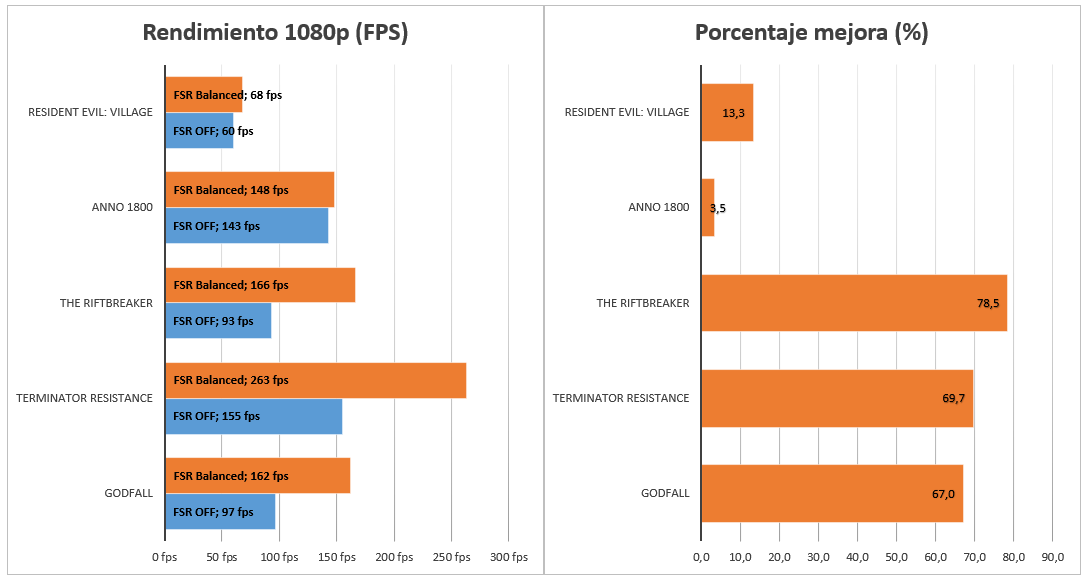
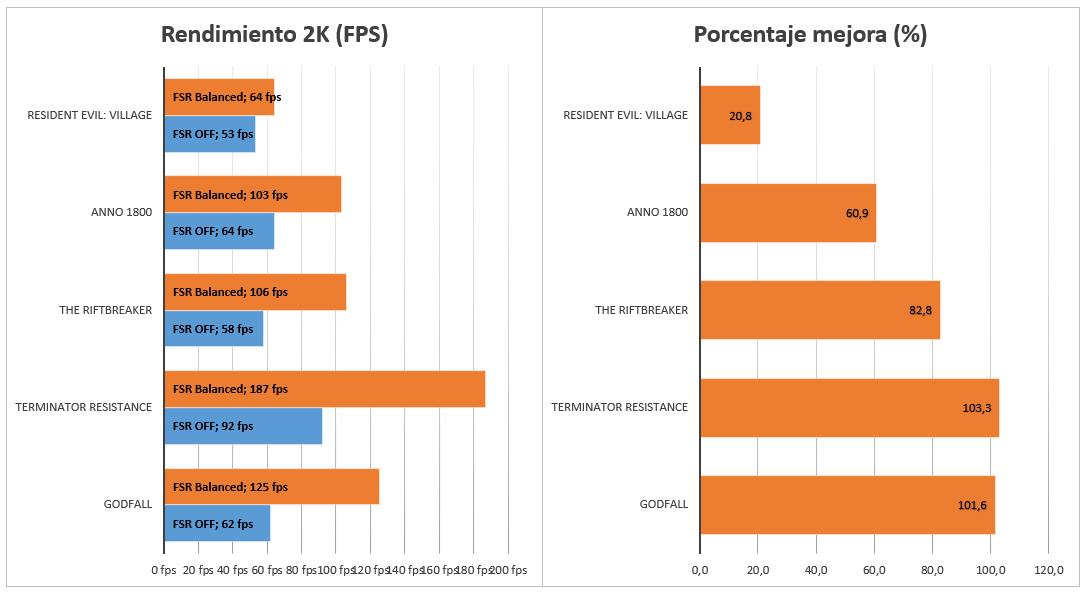

We increase the quality level for this test as it is a dedicated graphics card, and thus be able to compare it more objectively with the rest of the cards where we have evaluated FSR. That said, the improvements we see in Full HD resolution will be somewhat different from what the APU receives, reaching maximums of 78% in Riftbreaker . While Anno RE the increase is not as big as seen before, so this largely depends on how the GPU works internally.
The average increase increases in 2K up to 74%, with improvements of up to 100% in Terminator or Godfall, greatly improving their frame rate per second. RE is now the one with the fewest improvements, although the 60 FPS target is met and it gets a compromise between image quality and performance.
This takes a 360 or 4K turn, with Resident Evil doing the most performance boosts , from a mediocre 11 FPS to 53 FPS . The rest also go up to about 120%. So it can clearly be said that the higher the resolution, the better the FidelityFX Super Resolution works on the RX 6600 XT.
Comparison against other dGPUs
Taking advantage of the results obtained with the AMD Radeon RX 6600 TX in FSR, we are going to compare it with those obtained in the tests with the RX 6900 XT and the Nvidia RTX 3080 . Although the hardware is not exactly the same, the performance of the AMD Ryzen 9 5900X in games will be very similar to the Intel Core i9-10850K from the previous tests.


What interests us most will be the performance improvement we get in games with FSR enabled in balanced mode, as it is clear that the RX 6600 XT will have a lower pure performance than the others . But fortunately, we see that in the 2K resolution the card that gets the most improvements with FSR will be precisely the RX 6600 XT , and also by a lot of difference compared to the others with 100% in some titles. Of course, by going fairer in performance, the improvement is more striking.
In 4K it also maintains its composure and the improvements are slightly higher than the other cards, although the 3080 and 6900 XT come very close to it, exceeding an 80% increase in FPS.
Conclusions on FidelityFX Super Resolution on APU Cezanne and 6600 XT
It is always interesting to see how the new functions that manufacturers introduce work to improve the performance of their hardware, in this case in games. FidelityFX Super Resolution is a solution that will be especially useful for slightly more performance-sparing components such as the integrated graphics of a CPU , but it will also be of great benefit when playing high-resolution games in demanding games.
With the Ryzen 5 5600G we have shown that it is possible to play practically any game in low quality and Full HD at 30 FPS without too much trouble . But if we add FSR in the few titles that still have it, we can reach 60 FPS or touch them, already obtaining a very good experience at a very low price. Including we can allow ourselves to play in 2K with better image quality at more than 30 FPS, thus equaling the experience of many console games.
If we use it for dedicated graphics cards, we see that for the 6600 XT a little fairer in 4K resolution we will also get 60 FPS in many games , in high quality and even using Ray Tracing as in Resident Evil.
We are confident that releasing your code and being backward compatible with older cards and Nvidia is helping more and more titles adopt it. Or much better, let’s see FSR and DLSS as integrated options to use the one that best suits us based on our hardware functions.



